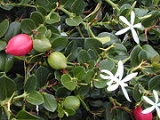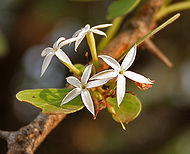
Carissa
Encyclopedia
Carissa is a genus
of about 20-30 species
of shrub
s or small tree
s native to tropical and subtropical regions of Africa
, Australia
and Asia
.
 The species have maximum heights between 2 and 10 m tall, with spiny
The species have maximum heights between 2 and 10 m tall, with spiny
branches. The leaves
are waxy and oblong, 3–8 cm long, and thick and leathery. The flowers are produced throughout most of the year; they are 1–5 cm diameter, with a five-lobed white or pink corolla, solitary or borne in clusters; some have a fragrance reminiscent of Gardenia
. This makes them popular garden plants. The fruit
is a plum-shaped berry
, red to dark purple-black in different species, 1.5–6 cm in length, and containing up to 16 flat brown seed
s. The fruit are edible but tart, and taste like a giant cranberry, though some also taste overtones of strawberry
or apple
-like flavour, and rich in Vitamin C, calcium, magnesium and phosphorus. The fruit of C. macrocarpa is especially delicious and is used to make jelly. They are eagerly consumed by birds, which also distribute the seed. If eaten before fully ripe, a bitter, latex-like substance is released from the skin. Other than the fruit, the plant is poisonous. This can also come in forms of a lovely bush. Because of its abundance of sharp thorns, the plant is often used as a security hedge.
Carissa species are grown from seed or cuttings and tolerate slight frost.
Genus
In biology, a genus is a low-level taxonomic rank used in the biological classification of living and fossil organisms, which is an example of definition by genus and differentia...
of about 20-30 species
Species
In biology, a species is one of the basic units of biological classification and a taxonomic rank. A species is often defined as a group of organisms capable of interbreeding and producing fertile offspring. While in many cases this definition is adequate, more precise or differing measures are...
of shrub
Shrub
A shrub or bush is distinguished from a tree by its multiple stems and shorter height, usually under 5–6 m tall. A large number of plants may become either shrubs or trees, depending on the growing conditions they experience...
s or small tree
Tree
A tree is a perennial woody plant. It is most often defined as a woody plant that has many secondary branches supported clear of the ground on a single main stem or trunk with clear apical dominance. A minimum height specification at maturity is cited by some authors, varying from 3 m to...
s native to tropical and subtropical regions of Africa
Africa
Africa is the world's second largest and second most populous continent, after Asia. At about 30.2 million km² including adjacent islands, it covers 6% of the Earth's total surface area and 20.4% of the total land area...
, Australia
Australia
Australia , officially the Commonwealth of Australia, is a country in the Southern Hemisphere comprising the mainland of the Australian continent, the island of Tasmania, and numerous smaller islands in the Indian and Pacific Oceans. It is the world's sixth-largest country by total area...
and Asia
Asia
Asia is the world's largest and most populous continent, located primarily in the eastern and northern hemispheres. It covers 8.7% of the Earth's total surface area and with approximately 3.879 billion people, it hosts 60% of the world's current human population...
.

Thorns, spines, and prickles
In botanical morphology, thorns, spines, and prickles are hard structures with sharp, or at least pointed, ends. In spite of this common feature, they differ in their growth and development on the plant; they are modified versions of different plant organs, stems, stipules, leaf veins, or hairs...
branches. The leaves
Leaf
A leaf is an organ of a vascular plant, as defined in botanical terms, and in particular in plant morphology. Foliage is a mass noun that refers to leaves as a feature of plants....
are waxy and oblong, 3–8 cm long, and thick and leathery. The flowers are produced throughout most of the year; they are 1–5 cm diameter, with a five-lobed white or pink corolla, solitary or borne in clusters; some have a fragrance reminiscent of Gardenia
Gardenia
Gardenia is a genus of 142 species of flowering plants in the coffee family, Rubiaceae, native to the tropical and subtropical regions of Africa, southern Asia, Australasia and Oceania....
. This makes them popular garden plants. The fruit
Fruit
In broad terms, a fruit is a structure of a plant that contains its seeds.The term has different meanings dependent on context. In non-technical usage, such as food preparation, fruit normally means the fleshy seed-associated structures of certain plants that are sweet and edible in the raw state,...
is a plum-shaped berry
Berry
The botanical definition of a berry is a fleshy fruit produced from a single ovary. Grapes are an example. The berry is the most common type of fleshy fruit in which the entire ovary wall ripens into an edible pericarp. They may have one or more carpels with a thin covering and fleshy interiors....
, red to dark purple-black in different species, 1.5–6 cm in length, and containing up to 16 flat brown seed
Seed
A seed is a small embryonic plant enclosed in a covering called the seed coat, usually with some stored food. It is the product of the ripened ovule of gymnosperm and angiosperm plants which occurs after fertilization and some growth within the mother plant...
s. The fruit are edible but tart, and taste like a giant cranberry, though some also taste overtones of strawberry
Strawberry
Fragaria is a genus of flowering plants in the rose family, Rosaceae, commonly known as strawberries for their edible fruits. Although it is commonly thought that strawberries get their name from straw being used as a mulch in cultivating the plants, the etymology of the word is uncertain. There...
or apple
Apple
The apple is the pomaceous fruit of the apple tree, species Malus domestica in the rose family . It is one of the most widely cultivated tree fruits, and the most widely known of the many members of genus Malus that are used by humans. Apple grow on small, deciduous trees that blossom in the spring...
-like flavour, and rich in Vitamin C, calcium, magnesium and phosphorus. The fruit of C. macrocarpa is especially delicious and is used to make jelly. They are eagerly consumed by birds, which also distribute the seed. If eaten before fully ripe, a bitter, latex-like substance is released from the skin. Other than the fruit, the plant is poisonous. This can also come in forms of a lovely bush. Because of its abundance of sharp thorns, the plant is often used as a security hedge.
Carissa species are grown from seed or cuttings and tolerate slight frost.
Selected species
- Carissa acuminata A.DC.
- Carissa arduina Lam.
- Carissa bispinosa (L.) Desf. ex Brenan
- Carissa boiviniana (Baill.) Leeuwenb.
- Carissa carandas L. – Karonda, Karanda, Karauda, Karaunda
- Carissa macrocarpaCarissa macrocarpaCarissa macrocarpa , is a shrub native to South Africa, where it is commonly called the Large Num-Num. In Zulu, as well as in the Bantu tribes of Uganda, it is called amatungulu. In Afrikaans the fruit is called Noem-Noem.C. macrocarpa deals well with salt-laden winds, making it a good choice for...
(Eckl.) A.DC. – Natal Plum, Large Num-Num, Noem-Noem (AfrikaansAfrikaansAfrikaans is a West Germanic language, spoken natively in South Africa and Namibia. It is a daughter language of Dutch, originating in its 17th century dialects, collectively referred to as Cape Dutch .Afrikaans is a daughter language of Dutch; see , , , , , .Afrikaans was historically called Cape...
), amatungulu (Zulu) - Carissa oblongifolia Hochst.
- Carissa opacaCarissa opacaCarissa opaca, locally called Garna,in Hindi ,it is called as Karounda. fruit is eaten ,flowers in perfumes ,roots in respiratory ailments...
Stapf ex Haines - Carissa ovataCarissa ovataCarissa spinarum, the Conkerberry or Bush Plum, is a large shrub of the dogbane family , widely distributed in tropical regions around the Indian Ocean. It is most well known in Australia, where it is also called Currant Bush or, more ambiguously, "native currant" or even "black currant"...
R.Br. - Carissa septentrionalis (Pichon) Markgr.
- Carissa spinarumCarissa spinarumCarissa spinarum, the Conkerberry or Bush Plum, is a large shrub of the dogbane family , widely distributed in tropical regions around the Indian Ocean. It is most well known in Australia, where it is also called Currant Bush or, more ambiguously, "native currant" or even "black currant"...
L. – Conkerberry, Bush Plum, Currant Bush, "native currant", "black currant" (Australia), Wild Karanda (India), anwekety (Anmatyerr), merne arrankweye (Arrernte), nganango (PintupiPintupiPintupi refers to an Australian Aboriginal group who are part of the Western Desert cultural group and whose homeland is in the area west of Lake MacDonald and Lake Mackay in Western Australia. These people moved into the Aboriginal communities of Papunya and Haasts Bluff in the west of the...
)
Formerly placed here
- Acokanthera oblongifolia (Hochst.) Codd (as C. oblongifolia Hochst.)
- Acokanthera schimperiAcokanthera schimperiAcokanthera schimperi , belonging to a family of Apocynaceae, is a small tree native to East Africa and Yemen.-Uses:...
(A.DC.) Benth. & Hook.f. ex Schweinf. (as C. schimperi A.DC.)

